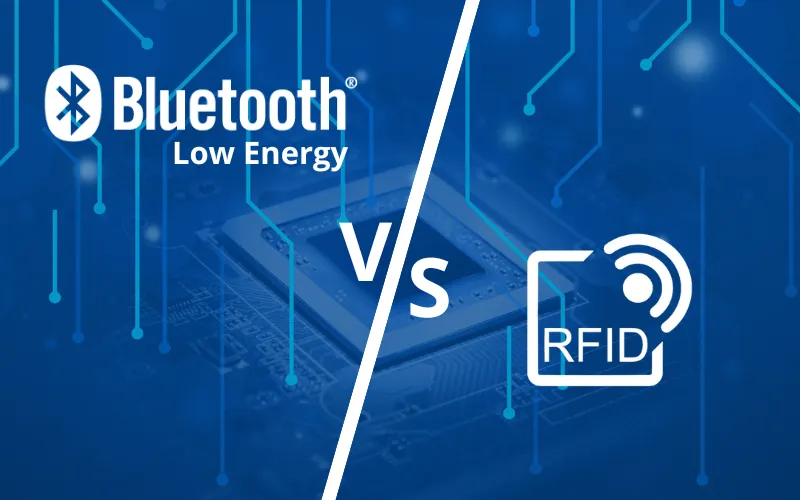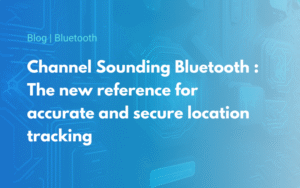
What is RFID (Radio Frequency Identification)?
RFID is a technology used to identify and track objects fitted with RFID tags. Tags can be passive, semi-passive or active. Passive tags have no battery and are activated by the RFID reader’s energy when they enter its reading field. RFID is widely used in logistics, inventory management and access control.
Active RFID: tags are powered by an on-board energy source. This may be a battery, for example, enabling the tag to operate and transmit data. It can also be passive RFID. Unlike active tags, passive tags do not contain an on-board power source. They rely on the wave emitted by the reader to power their chip, modulate the signal and, by backscatter, transmit the signal to the reader.
What is Bluetooth Low Energy (BLE)?
BLE is an energy-efficient version of conventional Bluetooth technology, designed for applications requiring low battery consumption. It enables devices to communicate over short distances with low power consumption. BLE is used in a variety of applications, including wearable devices, industrial sensors and IoT devices.
Operation: What are the differences between Active RFID and BLE?
Deciphering the technical infrastructure of Active RFID
An active RFID tag
The active RFID tag is a fundamental electronic identification medium. It is often made up of two main elements: an antenna, which receives the waves, and an electronic circuit, which processes and stores the information. In other words, it houses an identifier and data on a chip, itself connected to the antenna. The tag thus exchanges data with a reader via radio waves. Widely used in RFID, the tag is very useful for meeting traceability requirements, for example, since it doesn’t necessarily need to be seen to be detected and, consequently, read.
The reader
The reader is an electronic device used to transmit and receive electromagnetic waves. It detects and recognizes the tag’s identification information via the identifier supplied by the chip manufacturer. It is also able to decode the information carried by the incident wave, thanks to a decoder.
The RFID antenna
The RFID antenna, on the other hand, captures and transmits electromagnetic waves. The frequency of emission depends on the type of antenna, its length and the frequency set in the chip. Depending on the application, the antenna must be inexpensive, non-invasive and as environmentally friendly as possible. To maximize energy transmission, the antenna impedance must be equivalent to the impedance of the electronic chip contained in the tag. Most often, this impedance has a value of 50 omega.
The data storage system
To store data from active RFID tags efficiently, a robust communications infrastructure is needed to transfer information from RFID readers to a centralized data management system. This centralized system needs to be secure and capable of managing a variety of information collected by active RFID tags, such as movement history or temperature data.
Management software
The software is used to manage and monitor the RFID Active system. It can include functions such as tag and reader configuration, real-time data visualization, report generation, etc.
Network connectivity
To enable communication between the various components of the RFID Active infrastructure, network connectivity is required. This can include wired or wireless connections, such as Ethernet, Wi-Fi, or cellular networks.
BLE, a lightweight infrastructure that’s easy to deploy
A BLE device
The BLE device may be a beacon or a sensor, for example, and is a battery-powered, stand-alone device. At regular intervals, it transmits a sequence of alphanumeric data called a “Bluetooh frame”. This frame contains a unique identification number (UUID), as well as information such as battery level, sensor data and so on.
A gateway
A BLE gateway acts as a bridge between the BLE network and other networks, enabling data from BLE devices to cross different types of network to reach its destination. For example, it can transmit data between BLE devices and cloud servers via a Wi-Fi or cellular connection. It can also be equipped with local processing capabilities to aggregate, filter or analyze data from BLE devices before transferring it to other systems or services. In short, a BLE gateway plays an essential role in facilitating connectivity between BLE devices and other networks or services, aggregating and processing data, managing connections and ensuring secure communications.
The server or cloud to store and process data
Data from BLE devices is transferred by the gateway to a server or cloud for storage, processing and analysis. This can include operations such as data aggregation, format conversion, data integrity checking, or the application of specific business rules. The server can play a role in communications security by implementing authentication, encryption and access control mechanisms to protect data exchanged between BLE devices and other system components.
Management software
As with an Active RFID infrastructure, the final essential element is the management software. Essential for the end-user, the business application will enable him to visualize processed data in the form of graphs, histories or maps. They will also be able to administer their IoT network on this platform, according to different levels of access rights.

Discover our wide range of BLE sensors
renowned for their sturdiness and high autonomy
6 Advantages of Bluetooth Low Energy over RFID
1. Open protocol and interoperability
BLE is an open protocol, which means it is widely compatible with a diverse range of devices and systems. It is also compatible with iBeacon and Eddystone standards, offering great flexibility in industrial applications.
2. Lighter infrastructure
Unlike RFID, which requires specific infrastructures such as RFID readers and antennas, BLE can operate with lighter infrastructures. BLE devices can be integrated into existing equipment, or easily deployed with reduced installation costs.
3. Longer range and outdoor use
BLE generally offers a greater range than RFID, making it more suitable for certain industrial applications requiring communication over longer distances. Unlike Active RFID infrastructures, which tend to be dedicated to indoor use, BLE is 100% compatible with outdoor applications in fields such as transport and construction.
4. Low energy consumption
As its name suggests, Bluetooth Low Energy is designed to minimize energy consumption, making it ideal for battery-powered devices. This means longer battery life and more efficient use of energy resources.
5. Compatible with other wireless technologies
BLE is interoperable with other wireless technologies such as WiFi, making it easy to integrate with existing systems and exploit synergies between different technologies.
6. Easy to use
BLE is often simpler to implement than RFID, as it doesn’t require heavy infrastructure or complex calibration. This can mean faster deployment and easier integration into existing processes.
Why choose BLE technology for asset tracking?
Asset tracking is a crucial application in many industries, and choosing the right technology can make all the difference in terms of operational efficiency and profitability. With BLE, companies can benefit from a lighter infrastructure, reducing installation and maintenance costs while offering greater flexibility. What’s more, BLE offers a greater range than RFID, enabling assets to be tracked over longer distances with greater accuracy.
By choosing BLE for asset tracking, companies can benefit from a robust, flexible and cost-effective solution that meets the growing demands of asset management in a dynamic industrial environment.
Why choose BLE technology for access control?
In the field of access control, Bluetooth Low Energy (BLE) technology is positioning itself as an innovative and effective solution to meet growing needs for security and flexibility.
By opting for BLE, companies can benefit from simplified implementation and easy integration with existing systems. Unlike traditional solutions such as RFID, BLE offers interoperability with other wireless technologies such as WiFi, enabling centralized management and remote access monitoring.
What’s more, BLE’s extended range means it can cover larger areas, offering greater flexibility in the design of access control systems. Thanks to its low power consumption, BLE is also suitable for portable devices such as smartphones, offering users a convenient, wireless experience when identifying and authenticating.
By choosing BLE for access control, companies can benefit from a modern, secure and scalable solution that meets growing security requirements while offering an optimal user experience.
Why is BLE ideal for fleet management?
In the field of fleet management, Bluetooth Low Energy (BLE) is emerging as an innovative and adaptable solution to complex vehicle tracking and management needs. First and foremost, BLE allows for simplified implementation and seamless integration with existing GPS systems and telematics boxes.
Unlike RFID, BLE offers extensive compatibility with other wireless technologies such as WiFi, making it easy to collect and analyze data such as temperature in refrigerated trucks, door opening detection and geolocation, and trailer and driver identification.
Conclusion
RFID technology has long been an essential pillar in various industrial fields, offering an effective solution for asset tracking, inventory management and access control. However, with the advent of Bluetooth Low Energy (BLE), new opportunities are opening up. BLE offers extended interoperability, reduced power consumption and ease of deployment, positioning it as an attractive alternative to RFID, particularly in applications requiring greater flexibility and extended wireless connectivity. With Bluetooth Low Energy, companies can benefit from a modern, adaptable solution to the growing challenges of asset management and connectivity in an increasingly digital world.


